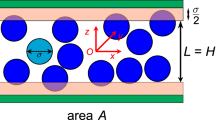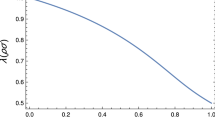Abstract
A “hole” in a fluid is specified in a well-defined manner. The concentration of “holes” is a thermodynamic property of the fluid and we derive this concentration in three different ensembles for a one-dimensional fluid of hard rods. The thermodynamics of these rigorously defined holes is developed, and the properties of holes are explored. The ensemble in which the concentration of holes is maintained fixed exhibits dramatic properties. Finally, pair correlation functions for hard rods in the various ensembles are computed. Contrary to a frequently made assumption, the equilibrium number of holes is found to never be proportional to the probability of finding a single hole in the fluid. Constraining the concentration of holes as well as the density leads to dramatic structural effects prominently displayed by the pair correlation function. The ensemble in which the concentration of holes is fixed is an example of an “internally constrained” metastable system.
Similar content being viewed by others
References
F. Cernuschi and H. Eyring,J. Chem. Phys. 7:547 (1939).
H. M. Peek and T. L. Hill,J. Chem. Phys. 18:1252 (1950).
J. S. Rowlinson and C. F. Curtiss,J. Chem. Phys. 19:1519 (1951).
M. Kurata,Busseiron Kenkyu 39:77 (1951).
I. Prigogine,The Molecular Theory of Solutions (North-Holland, Amsterdam, 1957), Chap. VII.
H. Eyring and M. S. Jhon,Significant Liquid Structures (John Wiley and Sons, New York, 1969), Chap. 3.
B. J. Alder and W. G. Hoover, inPhysics of Simple Liquids, H. N. V. Temperly, J. S. Rowlinson, and G. S. Rushbrooke, eds. (North-Holland, Amsterdam, 1968), Chap. 4.
D. W. Jepson,J. Math. Phys. 6:405 (1965).
J. L. Lebowitz and J. K. Percus,Phys. Rev. 155:122 (1967).
J. L. Lebowitz, J. K. Percus, and J. Sykes,Phys. Rev. 171:224 (1968).
M. Aizenman, J. Lebowitz, and J. Marro,J. Stat. Phys. 18:179 (1978).
S. F. Edwards,Disc. Faraday Soc. 49:43 (1970);Proc. Phys. Soc. (London) 91:513 (1967);J. Phys. A1:15 (1968);Proc. Phys. Soc. (London) 92:9 (1967).
K. F. Freed, inAdvances in Chemical Physics, Vol. XXII, I. Prigogine and S. A. Rice, eds. (John Wiley and Sons, New York, 1972).
E. Helfand, H. L. Frisch, and J. L. Lebowitz,J. Chem. Phys. 34:1037 (1961).
H. Reiss,Ber. Bunsen-Ges. Phys. Chem. 79:943 (1975).
H. Reiss and R. V. Casberg,J. Chem. Phys. 61:1107 (1974); Z. W. Salsburg, R. W. Zwanzig, and J. G. Kirkwood,J. Chem. Phys. 21:1098 (1953).
Author information
Authors and Affiliations
Rights and permissions
About this article
Cite this article
Elkoshi, Z., Reiss, H. & Hammerich, A.D. One-dimensional rigorous hole theory of fluids: Internally constrained ensembles. J Stat Phys 41, 685–708 (1985). https://doi.org/10.1007/BF01009028
Received:
Issue Date:
DOI: https://doi.org/10.1007/BF01009028




